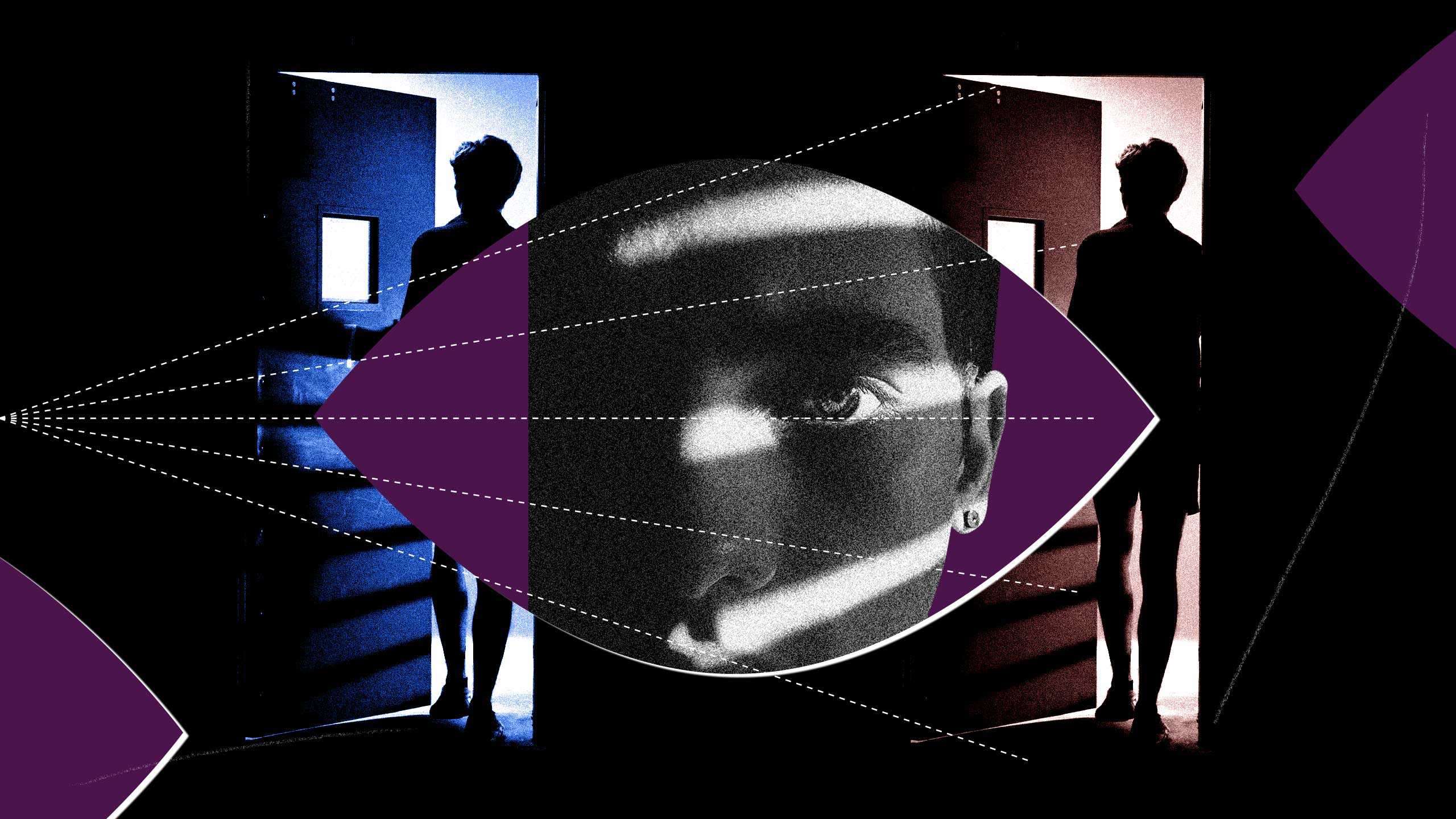Most of my life as a trans person has been conducted in isolation. My transition began in earnest just after the onset of the pandemic, in the spring and summer of 2020. The social life I’ve managed to build since then—the support groups, the friendships, the “mentoring” that is mostly just me sending frantic Twitter DMs about how I fucked up—has been entirely online. Now, here I stand, facing down Pride, realizing that I have virtually no idea how to be a queer person in the world.
The apparent spike in transitions during the pandemic is an anecdotal phenomenon—there are, as yet, no statistics to back it up. Still, there are some high-profile examples. Last month, singer Demi Lovato came out as non-binary; actor Elliot Page transitioned; and in December, comedian and actor Eddie Izzard announced she is now using all-female pronouns. Half the people I followed on social media switched up their pronouns, while the other half were already out. This person made the TikTok that will define a generation. It’s a thing.
It’s not that the pandemic made anyone trans. That would be like saying that a hurricane made someone gay. I knew I was trans long before lockdown started; I just wanted time to work things out with my family before throwing the process open to the world. Then again, the reason I knew was that I’d already turned my life upside down by having a kid and then by moving away from the city I’d lived in for 17 years. Shocks and upheavals have a way of shaking loose whatever you’re repressing. People construct safe, limiting personas that help them get through the day, and when the daily routine falls apart, the persona does, too.
The novel coronavirus was another upheaval, and a global one: billions of people had their day-to-day lives fall apart at roughly the same time and were left confronting their awkward, vulnerable, private selves. Understandably, there were some surprises. Yet “pandemic trans” is a highly specific experience; there’s a whole cohort of trans people whose coping skills and senses of self have been forged under historically unique conditions. We’re like deep sea divers coming up for air. It’s reasonable to worry that some of us will get the bends.
“There’s a whole cohort of trans people whose coping skills and senses of self have been forged under historically unique conditions.”
Isolation and physical distancing are miserable, but they also relieve one of the keenest transition anxieties: our bodies, and how we present them to the world, become less urgent when no one is looking. Cynthia, a trans woman who answered my call for stories about pandemic transition, had already developed a rhythm before COVID-19: feminine clothes on the weekends and guy mode for work. Working from home let her dress like herself every day, at which point she realized she didn’t want to switch. “I started to realize I was always happier in feminine clothing, and began to worry about eventually having to go back to an office,” she says.
I can confirm that the awkwardness of a transition is a lot easier to negotiate when there’s no one to impress. I didn’t rise one day, divinely anointed Non-Binary. I cut my hair, stopped shaving, bought new clothes, cut my hair again, tried wearing the old clothes, hated them, got an even worse haircut, had 47 panic attacks about buying a binder, bought the binder, realized that I never wanted to take off the binder, got a testosterone prescription, stopped taking the testosterone, got another haircut that I liked until someone on Twitter said I looked like Hitler and started testosterone again. I looked like a half-baked cake for years on end, and I might not have had the nerve to transition if I’d had friends or acquaintances looking on.
Keeping those acquaintances at arm’s length for the tough conversations can be useful, too. Coming out as a trans woman, which Cynthia did a few months into the pandemic, was a lot easier without the expectation of in-person communication. She posted the announcement on her social media platforms at midnight the night before her 40th birthday, and didn’t look at her phone for the rest of the day. “I think it was easier for me to come out online to almost everyone at once than it would have been face-to-face and one at a time,” she says.
It’s not that COVID-19 is some universally liberating force. It’s not a tremendously gender-affirming experience to be quarantined with your transphobic parents. It’s much harder to undertake a medical transition if you’ve lost your job. Even for those of us in safe situations, it is very hard to be a queer person alone. Calls to the Trans Lifeline have spiked since the beginning of the pandemic, and, aside from suicidal ideation and the virus itself, the single most common concern of callers was “lack of trans community.”
“The ability to choose how you are seen is precious. It’s also likely to go away.”
For many of us, our first steps toward finding that community have necessarily taken place online and at a distance. Physical distancing has facilitated the rise of accessible, long-distance options like Zoom support groups and meetups. Social media has become more important, and internet friendships feel more like real friendships. It’s easier to take a long-distance relationship seriously when next door might as well be the surface of the moon.
I occupy an odd mini-cohort of writers who came out as non-binary within a few months of each other. Connection with others seems to have been a pretty universal factor in why we went public when we did. Eve Ettinger, for instance, was already out to some people privately, but bringing their transness to the internet “was a way of asking people to treat me and see me a certain way, of giving myself permission to participate in community as an openly trans person,” they say. “The pandemic isolated us all so much more than we’d been before, so having community online became so much more vital for everyone.” Non-binary author Britni de la Cretaz had a strong support network, but Zoom culture allowed them to try dating as an openly trans person: “The enforced digital nature of the relationship allowed me to feel out what that was like,” they say. “I took a lot of selfies for that person, too, and it allowed me to figure out how I wanted to be seen.”
The ability to choose how you are seen is precious. It’s also likely to go away. Digital socializing involves a level of image curation that is impossible in the real world. Post-vax life means making ourselves visible, not just to the people we want to impress or seduce, but to strangers, who may well interpret them the wrong way.
“This is the only version of being trans I know, and I can’t be sure that what comes next will be better.”
“I’m really nervous about how it is going to feel to move through the world and be gendered as a woman by strangers,” de la Cretaz says. “I don’t experience a lot of dysphoria in my own body when I am validated and seen for who I am by the people around me. I haven’t felt the need to explore T or top surgery or even binding, and I anticipate that my feelings about some of those things may change.”
Pandemic transitioners are, of course, not fragile hothouse flowers. We can handle exposure to normal human social life, as generations of trans people have done before us. (I mean, I might not be able to handle it, but that was pretty true even before I transitioned.) Still, having seen firsthand how queer and trans identities flourish in the absence of social pressure, it’s reasonable to be a little worried about what happens when we all dive headfirst into the muck of unfiltered, awkward social interaction. This is the only version of being trans I know, and I can’t be sure that what comes next will be better.
Most of the pandemic transitioners around me seem to know where they’re going: They have affirming partners, or partners who are trans; they have friends, networks, chosen families; they have bars and coffee houses and places to be seen. They know where they’ll be for Pride and who they’ll be with, and for the most part, it won’t be at some cheesy corporate parade.
I won’t be at the cheesy corporate parade either, because my town doesn’t have one. The pandemic is still not over, and Pride will have to happen remotely, if at all. But I’m trying. I’m saying “hi” way too intensely to the lady wearing a “TRANS AND VISIBLE” shirt in the bookstore. I’m going to an actual professional to inflict one more regrettable set of choices on my head. I’m putting myself out into the real world, looking for the real queer people in it. What did I go through this last year for, if not that?


 Why you can trust Xtra
Why you can trust Xtra


